Total posts:
187
08/20/2010
On two occasions, in the early 15th and again in the early 16th century, there was a flood of Venetian silver coins into England. These exotic coins, known as ‘soldini’, became nick-named ‘galley-halfpennies’ after the Venetian galley-men who imported them. The reason for the flood of soldini was a serious shortage of English struck halfpennies in circulation. The fallout on the ground was severe, for a lack of pennies, halfpennies, and farthings affected everything from the purchase of bread to the payment of wages. The Venetian soldino was therefore a convenient, though illegal, alternative to the English halfpenny.
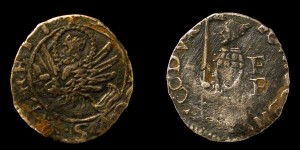
Venetian silver soldino of Doge Tomasso Mocenigo (1413-23).
Though the soldino looked like an English halfpenny, it in fact weighed slightly less and had a far lower silver content. So much lower in fact that the Council at Westminster commented in June 1400 that ‘three or four (soldini) are hardly worth one sterling’. Soldini therefore became a particular source of irritation for the English government, which, at various points in the 15th and 16th centuries attempted to rid the country of them through a series of restrictions and seizures.
Venetian merchants were among the most famous of the late medieval period, with trade networks covering the East, the Mediterranean and Northern Europe. Venetian galleys sailed to the East where they acquired luxury goods such as silks and spices, in particular pepper, which were highly sought after in Northern Europe. In the West the Venetian galleys habitually set out for England and Flanders during May and stayed until late August or early September, during which time they traded with England and loaded their galleys with wool and cloth to be sold in Italy, Greece and the Middle East. During the summer month’s soldini entered the English economy through exchange with Venetian merchants and quickly spread across the country.
Today, the Venetian coins of Late Medieval England are familiar due to the large quantity found through metal-detecting and systematically recorded on the Portable Antiquities Scheme database. The database contains information on over 260 examples and show that the majority of coins entered England in two substantial incursions: the first in 1400-c.1415 under Doge Michele Steno, the second in c.1501-1521 under Doge Leonardo Loredano.
The earliest textual evidence for the arrival of Venetian coins comes from a document dated to the year 1400, for which the numismatic evidence is in agreement. In June of that year a number of vessels from the annual trade fleet docked in London and its merchants began trading extensively with soldini. This caught the attention of the Council at Westminster, which promptly sought the advice of King Henry IV. The king took immediate action, instructing the Council to bring the laws against the circulation of foreign coins into force.
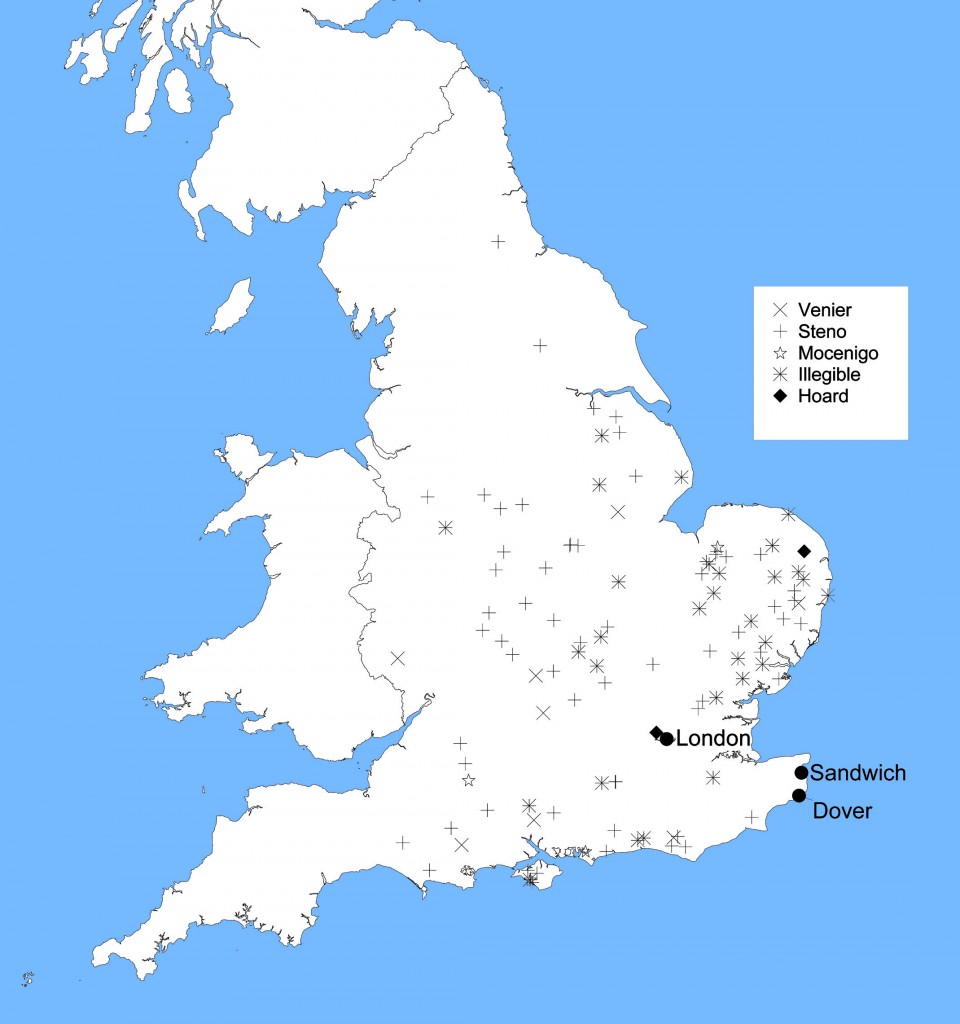
Soldini of the first incursion
In July 1400 a proclamation was made ‘strictly forbidding any liege or other man whatsoever henceforward in buying, selling or trafficking to pay or receive silver halfpence of Venice’. The sheriffs of the ports of London, Sandwich, and Dover were duly empowered and charged with the task of seizing any soldini they came across, an order which was repeated in June 1401.
The activities of the sheriffs seem, however, to have had only limited effect. Almost every year between 1400 and 1420, the sheriffs of London and Sandwich rendered account to the Exchequer of small parcels of galyhalpens which they had seized, though rarely did they sieze more than 400 coins in any one year. Clearly policing was a failure. It was now time to tackle the merchants of Venice and their senate directly.
On 28 June 1408, the government sent a writ to the masters of two Venetian galleys ordering them not to trade their coinage in any way. This was supported in 1414 by a directive sent to the mayor and the searcher of the port of London empowering them to forcibly search the galleys. Finally, in 1416, the English government persuaded the Venetian senate to forbid the export of their coinage to London. A Venetian document records this event.
In February 1416 the following decree was made: ‘Decree of the Senate for the fitting out of four galleys for the Flanders and London voyage. In consequence of the prohibition against the currency of Venetian halfpence to London, it is forbidden to take such halfpence to London by the London Galleys. Anyone doing so to be punished; and neither the vice captain, the master, nor any other man may intercede for such offender. The captain is bound before dismissing the London galleys to proclaim this Act on board them.’
Now that the source of coin had been dealt with, the Government turned to tackle Venetian soldini still in general circulation. A proclamation was made in 1415 that ‘all soldini should be taken to the Kings Exchanges to be defaced and sent to be minted. Furthermore, those found with soldini after Easter 1416 were to be heavily fined, with half of the fine to be paid to the informer as reward.’ These measures proved highly effective.
Despite the trauma of the first incursion, the government a hundred years later again failed to strike enough halfpennies. During the late 15th century, Venetian galleys changed their ports of call from London and Sandwich to Southampton. Once again, the lack of English halfpennies was met with a ready supply of similar-sized coins supplied by Venetian merchants; however by this time other batches of coin were arriving overland in ordinary commercial couriers’ bags sent weekly from the major Italian states and terminating at Bruges and Antwerp. A Venetian document records such an event, in which we read of Gerolamo Priuli sending 14,000 soldini overland in five batches in the ordinary commercial couriers’ bags to his brother Vicenzo in London in May, June, and September 1505.

Soldini of the second incursion
All coins of the second incursion were finally removed from circulation with the major re-coinage of silver in England beginning in 1526, though no doubt some were retained as curiosities and souvenirs, and some even to be used as a source of silver for jewellery, such as this button from Harlaston, Suffolk, made from a soldino of Doge Leonardo Loredan.
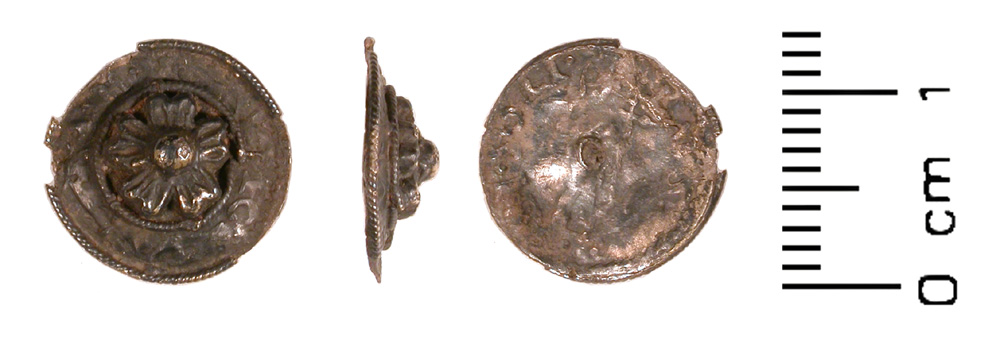
Silver Venetian soldino of Doge Leonardo Loredan (1501-21) made into a brooch (Treasure Reference no. 2007 T627).
The presence and distribution of these tiny exotic coins tells us that the English government was successful in stamping out the circulation of Venetian coinage shortly after each batch was imported by the galleys. Ironically, however, we find that the government did not learn from its mistakes. Indeed, three further episodes of coin shortage were on the horizon (1640-1670, 1789-1797, and 1810-1820) though in all of these cases the response was large-scale striking of unofficial copper token coinage rather than the importation of foreign silver.
08/20/2010
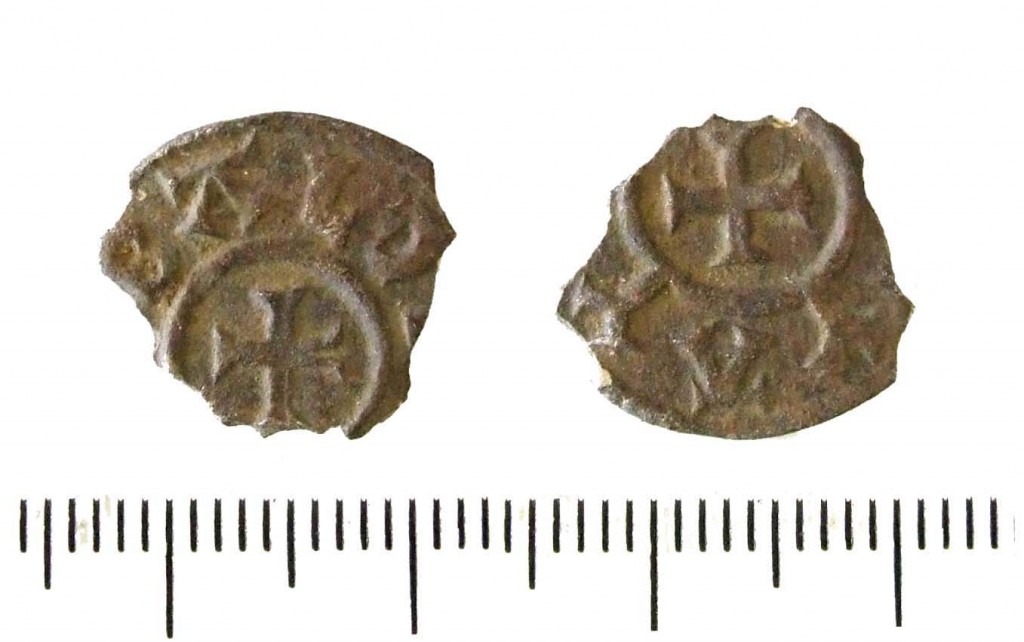
This broken silver penny was recently brought in to me for recording, found near Lincoln.
Though the coin is broken, enough detail survives to tell us that it was struck at Canterbury around 823/6 for Baldred ‘King’ of Kent. You might be forgiven for not knowing anything about Baldred for he is only briefly mentioned in a couple of sources.
The obverse depicts a cross pattee with the legend [+]BALD[RED REX], ‘Baldred, King’. The reverse also depicts a cross pattee but has a legend reading [+OB]A divided by (four) forked ends.
Despite the coin naming Baldred as King of Kent there is some doubt over this claim as the Anglo-Saxon Chronicle actually names Beornwulf as King of kent instead. Oddly though no coins were struck for him. Instead, coins were only struck for Baldred.
It is possible that Baldred was set up as an under-king by Beornwulf as had been done by a number of Kings before him.
Regardless, Baldred fled Kent when the West Saxon army invaded Kent in 826/7 and from then on disappears from the pages of history.
The wikipedia page for Baldred states that only 15 coins are known for him, though there are currently two recorded on the PAS database – the one from near Lincoln (LIN-C999B4) and the other from Northampton (NARC-0987A1).
Notes for coin-geeks: The coin is a non-portrait variety with the reverse legend divided by (four) fourchee ends.This coin is paralled only by an example from Warwickshire recorded on the Fitzwilliams’ Early Medieval Coin Index no. 2004.0098, published in the Coin Register 2005, no,. 151. This coin is an unpublished variety of BLS BI.9 (North 215 with forks in place of the cross moline ends on the reverse).
08/16/2010
I’m afraid (or possibly rather pleased) it has been very busy here with many finds to record so I have not posted for a while. To make up for it here are three interesting finds from the last few weeks to bring to your attention, unusually two of them involve iron which due to its poor of preservation in disturbed contexts such as plough soil is often poorly represented amongst the stray finds we deal with. The vast majority of iron items we see are either modern, where they can be identified usually from farm machinery, or small fragments which are so corroded and fragmentary as to make identification impossible.
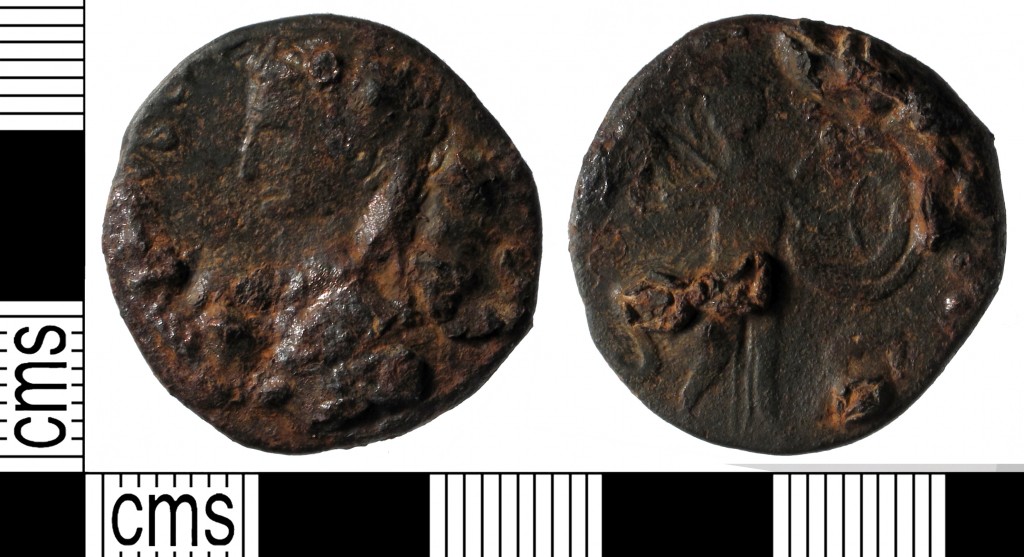
SUSS-846943 is a contemporary copy of a Roman coin with an iron core and copper outer surface. If you zoom in closely on the image you can see where the iron core has rusted, expanded and ‘exploded’ through the copper surface. Contemporary copies (as opposed to modern fakes) of Roman coins are not uncommon. Firstly there are the very common copies of radiates and mid-to late 4th century nummi made in something close to the right metal but smaller in size. Secondly there are copper cored silver coins; these are also not rare, it sometimes feels like there are as many contemporary copies of later 2nd century denarii out there as official types. Here are two typical silver plated copper cored coins in different states of preservation, the one on the right shows how the plating is often still in good condiiton and hard to spot.
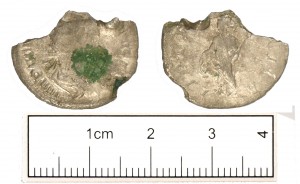 ](/findsorgukblogs/files/2010/08/SUSS-E88FF4.jpg)
](/findsorgukblogs/files/2010/08/SUSS-E88FF4.jpg)
Iron cored copies of precious metal coins are know (e.g. SUR-379FD1 and KENT-68D276) but are much rarer than copper cored examples. It could possibly be an accident of preservation with the iron rusting away to nothing but if that was the case you might expect more partially corroded and damaged examples to come to light, after all the gold and silver casings are not negligible in size. This suggests this coin is rare in general in having an iron core as well as being highly unusual as a plated copy of a copper coin.
The coin being copied is an As of Claudius I with Minerva on the reverse. Contemporary copies of these coins are not at all unusual, they are often crude and ‘barbarous’ in style with the left facing long necked head on the obverse and figure advancing right with circular shield flanked by a large ‘S-C’ on the reverse being all that clearly remains of the original design, like this second example. There are many recorded on the database and using the new Roman numismatic search you can quickly pull out all the As of Claudius I for comparison.
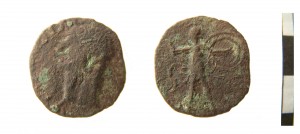
Copies of Claudian As are common on early military sites and there is some suggestion that they may in fact have been minted semi-officially by local garrisons who were used to having small change to use for transactions. The argument runs that in the early days after the conquest there was not enough coinage in the country for soldiers everyday needs so they produced their own (see Boon, G. 1988, ‘Counterfeit Coins in Roman Britain’ in Casey & Reese eds., C_oins and the Archaeologist_ London). Civilian populations in some areas, including Sussex, has also got used to low value coins including copper before the conquest and may have felt their lack and produced local alternatives.
In terms of ‘fakes’, excluding modern copies there are three main categories, firstly there are precious metals coins with cores of lower value metals, definitely contemporary copies or fakes designed to deceive, secondly there are smaller and crudely made ‘barbarous copies’ which don’t deceive for an instant and therefore must have been tolerated by the person paid in them, if not, usually, state officials, thirdly there are reasonably made copies in something that looks close to the original metal, these may have operated similarly to the second group or be passed off as genuine coins. While as a cored copy we would usually place this coin in the first category as part of a group with crudely copied designs it perhaps sits more happily in the second group. Interesting BH-40AF20 one of the few other iron cored copper coins I have traced is a barbarous radiate, again part of our second group of copies.
If both the buyer and seller happily use it to settle a transaction knowing it is not an ‘official coin’ we could argue it stops being a ‘fake’ and becomes something else, perhaps the best word for it is ‘token’ (but the long ‘when is a coin not a coin’ discussion is definitely one for another occasion…)
08/16/2010
August 16th, 2010 by Frances McIntosh
Although the vast majority of finds I record are found by metal detectorists, every now and again I get something different in. This jetton was found by the father of the man who brought it in to me, in his market garden in the 1950s. The gardens now no longer exist, being underneath a housing estate in North Shields. Thankfully the man reporting the find remembered exactly where it used to be and so we have a good findspot. It does look rather wierd on the map, coming from such an urban area- but that shows the changes in the area in the last century.
The jetton is in good condition and has been identified as a French jetton, dating from c.1497-1521. It has been recorded on the database if you would like to look more closely at it DUR-106F90.
Obverse- SIT NOMEN BENEDICTVM (garbled); in centre V (for Virgo- Virgin Mary)
Reverse- similar legend; in centre cross pattee with a flower in each angle
A jetton can be described a metal counter used in calculation of financial sums but not itself directly exchangeable for coins, goods or services. If you search the PAS database for jettons you will see there are just over 3800 examples recorded there. Many of the examples found in Britain come from abroad, particularly France and the Low Countries, with c.800 coming from Nuremberg. I chose to put this example onto my blog as although jettons are fairly common finds from metal detectorists this is a slightly unusual type and also came with a different discovery method.

French jetton
08/16/2010
This week sees the beginning of the new BBC2 series entitled ‘Digging for Britain’; it is presented by Alice Roberts and produced by 360 Production and sees heavy involvement from the Scheme and features several high profile discoveries. The screening dates are:
- Episode 1 Romans – Thursday 19/08/10 21:00 BBC2
- Episode 2 Pre-history – Thursday 26/08/10 21:00 BBC2
- Episode 3 Anglo-Saxon – Thursday 02/09/10 21:00 BBC2
- Episode 4 Tudors – Thursday 09/09/10 21:00 BBC2
The preview videos from 360 Production below, gives you some more details about what the series will feature, the first introduces the series and makes reference to the 360 production website; the second features one of the Scheme’s alumni, Caroline McDonald.
You can read more about this production on 360′s blog and there’s a few newspaper articles already floating around (listed below):
08/10/2010
August 10th, 2010 by Frances McIntosh

Maceheads are items which are rarely found in Britain, the PAS database has less than 15 recorded. There is a focus in central England (apparently Lincs. in particular), though a number exist close to coasts and waterways. It is thought they originated as weapons in Scandinavia.
Maceheads are copper alloy items usually shafted onto wooden poles. Some exampels have been found with remnants of the shaft still inside the copper alloy head. However the size of some of them excludes their use as a weapon and so their exact use remains unclear.
Adam Daubney, the Lincolnshire FLO has written an extremely interesting paper which will be published soon on these items (forthcoming in 10 years of discovery PAS volume, to be published by British Archaeological Reports). In this paper he suggests an alternative use for mace heads, as part of religious costume.
An example found in Cleveland, recorded as DUR-5ACBE0 on the database seems to be slightly out of the expected distribution area, however it does fit what Adam has noted with the costal distribution as was found less than 5 miles from the North East coast. Its form is the usual hollow cylinder of copper alloy, with three rows, each of four pyramid-shaped spikes at the top of the mace. Each of the rows is offset 90 degrees from the adjacent row. As is usual for these maceheads, the upper and lower rows are of half-pyramid-shaped spikes, while those on the central row are of full pyramid shape.
The finder of this item has kindly agreed to allow us to test the macehead to find out the alloy composition. This testing will take place either at Cardiff or the British Museum and will be non-destructive but will provide extremely useful information about this enigmatic group of objects. I will update you when we get the results in from this testing. If you are interested in this type of object do look on the PAS database for further examples and look out for the publication by Adam on these.
Tags: North East find
Posted in Uncategorized | Comments (0)






 ](/findsorgukblogs/files/2010/08/SUSS-E88FF4.jpg)
](/findsorgukblogs/files/2010/08/SUSS-E88FF4.jpg)

